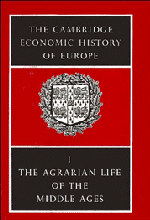Book contents
- Frontmatter
- Chapter I The Settlement and Colonization of Europe
- Chapter II Agriculture and Rural Life in the Later Roman Empire
- Chapter III The Evolution of Agricultural Technique
- Chapter IV Agrarian Institutions of the Germanic Kingdoms from the fifth to the ninth century
- Chapter V Agrarian conditions in the Byzantine Empire in the Middle Ages
- Chapter VI The Rise of Dependent Cultivation and Seignorial Institutions
- Chapter VII Medieval Agrarian Society in its Prime
- §1 France, The Low Countries, and Western Germany
- §2. Italy
- §3 Spain
- §4 The lands east of the Elbe and German colonization eastwards
- §5 Poland, Lithuania and Hungary
- §6 Russia
- §7 England
- §8 Scandinavia
- Chapter VIII Crisis: From the Middle Ages to Modern Times
- BIBLIOGRAPHIES
- Plate Section
- The Roman frontier and the Teutonic Tribes in the first and fourth centuries A.D.
- The Empire of Charles the Great
- Germany in the thirteenth century
- References
§7 - England
from Chapter VII - Medieval Agrarian Society in its Prime
Published online by Cambridge University Press: 28 March 2008
- Frontmatter
- Chapter I The Settlement and Colonization of Europe
- Chapter II Agriculture and Rural Life in the Later Roman Empire
- Chapter III The Evolution of Agricultural Technique
- Chapter IV Agrarian Institutions of the Germanic Kingdoms from the fifth to the ninth century
- Chapter V Agrarian conditions in the Byzantine Empire in the Middle Ages
- Chapter VI The Rise of Dependent Cultivation and Seignorial Institutions
- Chapter VII Medieval Agrarian Society in its Prime
- §1 France, The Low Countries, and Western Germany
- §2. Italy
- §3 Spain
- §4 The lands east of the Elbe and German colonization eastwards
- §5 Poland, Lithuania and Hungary
- §6 Russia
- §7 England
- §8 Scandinavia
- Chapter VIII Crisis: From the Middle Ages to Modern Times
- BIBLIOGRAPHIES
- Plate Section
- The Roman frontier and the Teutonic Tribes in the first and fourth centuries A.D.
- The Empire of Charles the Great
- Germany in the thirteenth century
- References
Summary
The Land
Reclamations
The course of English agriculture in the Middle Ages was dominated by the history of the land itself – its productivity, its relative abundance or scarcity, its use and distribution. This history is not yet ready to be written, but what has already emerged from its study is sufficient to enable us to map out its course and to place its main signposts.
Of the signposts the most important is the one which historians have placed at the beginning of the road, i.e. on the morrow of the Norman Conquest. This post is commonly taken to mark the birth of the English Middle Ages proper; but paradoxically enough what makes it so significant for historians of English land is that it stands a long way past the true starting point in English land settlement. To use the expression popularized by Mr Lennard, rural England of 1066 was already an old country. An historian of internal colonization must now accept that by 1066 the occupation of England by the English had gone far enough to have brought into cultivation and covered with agricultural settlement most of the area known to have been occupied in later centuries of English history. Most of the place names which were to form the grid of English parishes in subsequent centuries were in existence and recorded as settlements in the Domesday Book. Except in some regions, such as the eastern fens reclaimed in the seventeenth century or parts of Yorkshire devastated by the Conqueror or Welsh marches in the West and the Scottish borderlands in the North, the parish names of pre-eighteenth-century England already appear in 1066.
Keywords
- Type
- Chapter
- Information
- Publisher: Cambridge University PressPrint publication year: 1966
References
- 15
- Cited by

